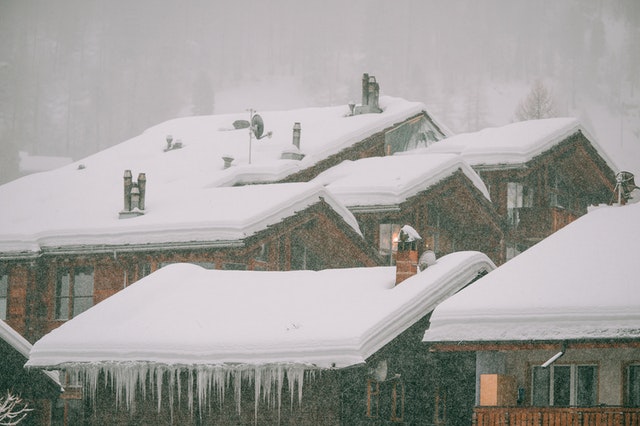
Understanding your roof’s weight restrictions in the winter is critical to your safety. Without tracking your roof’s buildup, it’s impossible to know when to remove snow or to call an expert for help.
While some homes would never encounter this issue because of their steep roof pitch, among other factors, others will require periodic inspection to avoid damage or collapse. So which category are you in?
What Factors Affect a Roof’s Snow Storage?
It’s challenging to determine the maximum amount of snow that a roof can withstand since there is no one-size-fits-all answer. In essence, different factors are in play.
The Weight of the Snow
One of the most important considerations is the snow’s weight. The weight fluctuates depending on the snow—wet snow can weigh up to two or three times more than fluffy snow.
A cubic foot of wet snow weighs around 20 pounds. On the other hand, a pound of snow weighs seven pounds when it is scorched. In general, the amount of snow your roof can withstand depends on how moist the snow is.
Design of the Roof
Roofs can keep snow differently depending on their design. Snow will easily fall off a steep, smooth roof. A flat or gently sloping roof retains more snow.
But just because it can carry loads of snow doesn’t mean it should. Typically, a single-sided gable roof is suitable for snowy climates. Sophisticated roofs with variable inclines don’t quickly shed snow, water, or ice.
Another important factor is vents. If your roof has vents, they will inevitably weaken it. So, for instance, a roof with skylights will not perform as well as a roof with no vents for snow.
Materials for The Roof
Roofs made of sturdy materials continually withstand more snow than those built with soft material. For example, slate shingles or asphalt endure lots of snow—fragile material, mostly buckle.
Roof Status
It’s essential to bear in mind that even the most rigid roofs eventually fail. So, how can you tell whether your roof is in danger of failing? Check the age. Your roof’s age is vital because, while most robust roofs last for approximately 20 years, they degrade as they approach the anticipated life span.
Signs for a Weak Roof
A weak roof has a few warning indicators. First, you may notice bending or cracking in your attic’s rafters. Cracked or bowed rafters indicate that your roof may not be able to withstand much snow.
You may also check if your roof is weak by inspecting your door frames. For instance, check your house’s second-floor door frames if you live in a storied house. Your roof may be deteriorating if the drywall is cracked.
A leaking attic is another indicator of a weak roof. If there is water in the attic, it is most likely flowing in through the roof. Look for missing shingles, corroded flashing, and creaking. If you suspect a weak roof, call a professional.
Do You Need to Clean Your Roof of Snow?
Unless your roof is exceptionally unstable and snowy, you shouldn’t worry about clearing snow—it’s risky and often useless. Your home was built to withstand all weather conditions. Local building laws require snow-resistant roofs on all houses.
If you must clean snow from your roof, you need to take measures. In snowy circumstances, going on your roof is risky. On the other hand, a roof rake can be used to safely clear snow from a single-story roof. Nevertheless, leave it to the professionals if you want to clear snow from a two-story roof.
Symptoms of a Loaded Roof
Aside from understanding how much snow your roof can handle, you also need to know when to clear it. Here are several warning indicators.
- Squeaking, Popping, or Cracking – Consider these noises as a sign that the roof is sagging. The sound of creaking, groaning, or breaking suggests the weight of the snow is too much to handle. So call professionals and have them clear it.
- Water Stains of Ceiling Warping – Look for water stains on your ceilings. These can indicate a leaking roof.
How About Ice Dams?
You might get tempted to clear snow to prevent ice dams. But there are other options. Using roof melt prevents ice from forming on your roof. You might also use a roof rake to remove snow and ice.
Remember that snow and ice on your roof evaporate heat from your attic, causing ice dams. It runs off your roof and freezes. You can avoid ice dams by preventing heated air from escaping your attic.
So, ice dams shouldn’t be an issue when you seal your attic properly. Be sure to call a professional and have them inspect and seal your attic, if necessary.
How to Estimate Your Roof’s Capacity to Hold Snow?
Consult the roofer who erected your roof for professional advice—they know the local codes and your roof’s capabilities.
Also be sure to call a professional roofing firm if your roof is aged. They will evaluate it and determine its snow capacity. They’re in a better position to tell you your roof’s snow capacity because of their work experience. They may advise you to make repairs to strengthen your roof.
So do you have any questions regarding your roof’s capabilities? Call us today. Don’t risk your time and health removing snow from your roof.





